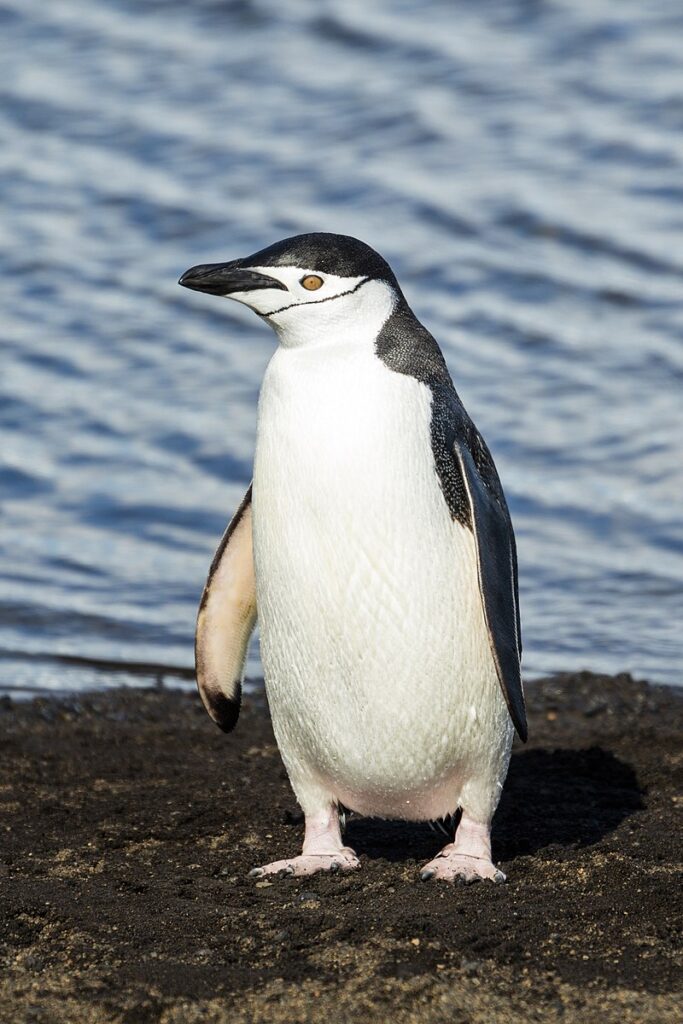Chinstrap penguins are a species of penguin that are found in the southern hemisphere. They are known for their distinctive black and white coloring, with a black line running from their beak to under their chin that gives them their name. These penguins are also relatively small, standing at around 2 feet tall and weighing between 3 and 7 kg.
Chinstrap penguins are native to the Antarctic and sub-Antarctic regions, with breeding colonies found on islands and coasts throughout the region. These penguins are known for their high-pitched braying calls, which they use to communicate with one another. They are also known for their ability to swim quickly, with speeds of up to 20 miles per hour.
These penguins are carnivorous, feeding primarily on krill and other small fish. They are able to dive to depths of up to 70 meters to catch their prey, staying underwater for up to two minutes at a time. Chinstrap penguins are also known for their breeding habits, with colonies of up to 10,000 penguins gathering to breed and raise their young.
Breeding typically takes place during the Antarctic summer, with the female laying two eggs in a nest made from stones and grass. Both parents take turns incubating the eggs and caring for the chicks, with each parent spending up to two weeks at a time caring for the young. Once the chicks are old enough to be left alone, the parents will head out to sea to hunt for food.
Despite their seemingly tough exterior, chinstrap penguins are facing a number of threats in the wild. Climate change is causing melting ice and rising sea levels, which can impact the availability of food for these penguins. Overfishing and pollution are also concerns, with plastic waste posing a particular danger to these birds. Conservation efforts are underway to protect chinstrap penguins and their habitats, including the creation of protected marine areas and efforts to reduce pollution.
Chinstrap penguins are a fascinating species of penguin that are known for their distinctive black and white coloring, their braying calls, and their ability to swim quickly. These penguins are facing a number of threats in the wild, but conservation efforts are underway to protect them and their habitats. By learning more about these amazing birds and supporting conservation efforts, we can help ensure that chinstrap penguins continue to thrive in the years to come.

Chinstrap penguins have appeared in various forms of popular culture, including:
- Happy Feet: Chinstrap penguins are featured in the animated film Happy Feet (2006) as some of the supporting characters. The film depicts the life of a penguin named Mumble, who is unable to sing but is a great dancer.
- Penguins of Madagascar: The popular animated TV series, Penguins of Madagascar, features a group of four penguins including a Chinstrap penguin named Private. The show follows the adventures of the penguins as they carry out various missions.
- BBC’s Frozen Planet: Chinstrap penguins are one of the penguin species featured in the documentary Frozen Planet (2011) produced by the BBC. The series explores the wildlife and landscapes of the polar regions.
- March of the Penguins: Chinstrap penguins also make an appearance in the documentary March of the Penguins (2005). The film follows the annual journey of emperor penguins in Antarctica, including their mating rituals and efforts to protect their young.
- Club Penguin: In the online multiplayer game Club Penguin, players can adopt a virtual Chinstrap penguin as their pet.
- The game “Assassin’s Creed Rogue” has a setting in the Antarctic region, which features the chinstrap penguins.
- The short film “Piper” which played before the theatrical release of “Finding Dory” features a baby chinstrap penguin as the main character.
Overall, Chinstrap penguins have become a popular symbol of the Antarctic and its unique wildlife, appearing in various forms of media and entertainment.